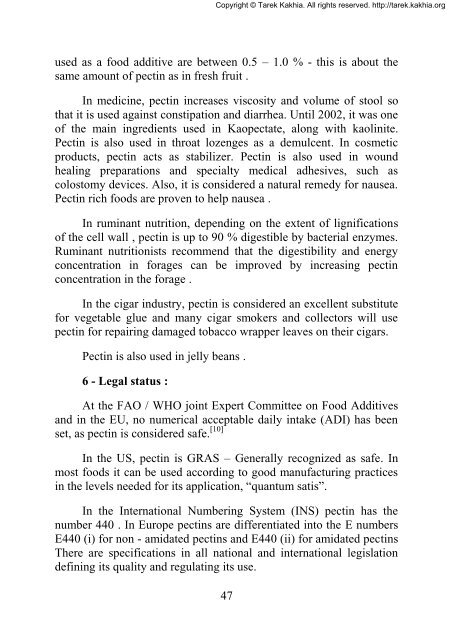You also want an ePaper? Increase the reach of your titles
YUMPU automatically turns print PDFs into web optimized ePapers that Google loves.
used as a food additive are between 0.5 – 1.0 % - this is about the<br />
same amount of pectin as in fresh fruit .<br />
In medicine, pectin increases viscosity and volume of stool so<br />
that it is used against constipation and diarrhea. Until 2002, it was one<br />
of the main ingredients used in Kaopectate, along with kaolinite.<br />
Pectin is also used in throat lozenges as a demulcent. In cosmetic<br />
products, pectin acts as stabilizer. Pectin is also used in wound<br />
healing preparations and specialty medical adhesives, such as<br />
colostomy devices. Also, it is considered a natural remedy for nausea.<br />
Pectin rich foods are proven to help nausea .<br />
In ruminant nutrition, depending on the extent of lignifications<br />
of the cell wall , pectin is up to 90 % digestible by bacterial enzymes.<br />
Ruminant nutritionists recommend that the digestibility and energy<br />
concentration in forages can be improved by increasing pectin<br />
concentration in the forage .<br />
In the cigar industry, pectin is considered an excellent substitute<br />
for vegetable glue and many cigar smokers and collectors will use<br />
pectin for repairing damaged tobacco wrapper leaves on their cigars.<br />
Pectin is also used in jelly beans .<br />
6 - Legal status :<br />
Copyright © Tarek Kakhia. All rights reserved. http://tarek.kakhia.org<br />
At the FAO / WHO joint Expert Committee on Food Additives<br />
and in the EU, no numerical acceptable daily intake (ADI) has been<br />
set, as pectin is considered safe. [10]<br />
In the US, pectin is GRAS – Generally recognized as safe. In<br />
most foods it can be used according to good manufacturing practices<br />
in the levels needed for its application, “quantum satis”.<br />
In the International Numbering System (INS) pectin has the<br />
number 440 . In Europe pectins are differentiated into the E numbers<br />
E440 (i) for non - amidated pectins and E440 (ii) for amidated pectins<br />
There are specifications in all national and international legislation<br />
defining its quality and regulating its use.<br />
47







